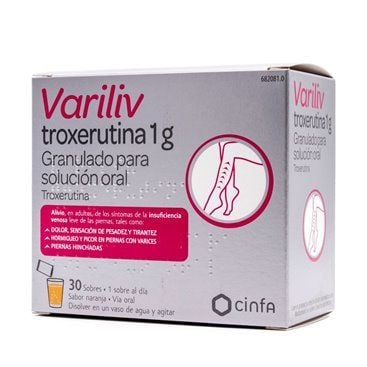Variliv Troxerutin 1000 mg 30 Sachets Granulated Oral Solution
It is indicated, in adults, for the relief of the symptoms of mild venous insufficiency of the legs, such as: pain, a feeling of heaviness and tightness, tingling and itching in legs with varicose veins and swollen legs.
It is indicated, in adults, for the relief of the symptoms of mild venous insufficiency of the legs, such as: pain, a feeling of heaviness and tightness, tingling and itching in legs with varicose veins and swollen legs.
Variliv Troxerutin (1 G 30 Envelopes Granules For Oral Solution)
Troxerutin
ACTION AND MECHANISM
- Vasoprotector. Oxerutins are a mixture of bioflavonoids derived from rutoside. The majority is troxerutin (trihydroxy-ethyl-rutoside), although mono-, di- and tetrahydroxylated derivatives also appear.
Troxerutin has a high affinity for the capillary endothelium and venules, protecting cells against oxidative stress.
After administration, they lead to a decrease in vascular permeability, restoration of the venoarteriolar reflex, an increase in venous filling time and an increase in transcutaneous oxygen pressure. All these effects have as a final consequence the reduction of edema in the legs.
PHARMACOKINETICS
Orally:
- Absorption: they suffer a high first pass effect on the liver and enterohepatic circulation. Cmax is reached 2-3 h after the administration of 2 g.
Effect of food: they do not seem to affect the absorption of oxerutins.
- Distribution: low plasma protein binding (27-29%). It is widely distributed, accumulating especially in the endothelium, from where it is slowly released into the circulation. It does not pass through BHE.
- Metabolism: partially by hepatic glucuronidation.
Enzyme inducing / inhibiting capacity: quercetins exert an enzymatic inhibitory effect on cytochrome P450 in vitro, but not in vivo.
- Elimination: in feces (65%) and urine (3-6%), with a complete elimination in 48 h. The t1 / 2 is 18.3 h.
Pharmacokinetics in special situations: There are no pharmacokinetic data in children, the elderly or patients with renal or hepatic impairment.
INDICATIONS
- Treatment of the symptoms of mild [VENOUS INSUFFICIENCY] in adults.
POSOLOGY
- Adults: 1 g / 24 h, preferably in the morning with breakfast. It can be administered as a single dose, preferably during breakfast, or in the case of the oral solution as two equal doses.
- Children and adolescents <18 years: not recommended.
- Elderly: does not require dosage adjustment.
Duration of treatment: continue treatment for 2-3 months. Treatments in clinical trials lasted for periods of up to 4 months.
If the symptoms do not improve in the first 2 weeks, reevaluate the diagnosis.
Reinstatement of treatment: in case of reappearance of symptoms, treatment could be repeated.
Missed dose: administer the next dose at the usual time. Do not double the next dose.
DOSAGE IN KIDNEY INSUFFICIENCY
No specific dosage recommendations have been made.
DOSAGE IN LIVER INSUFFICIENCY
No specific dosage recommendations have been made.
RULES FOR CORRECT ADMINISTRATION
- Envelopes: dissolve the contents of the envelope in a glass of water, and drink immediately.
Administration with food: can be taken with or without food.
CONTRAINDICATIONS
- Hypersensitivity to oxerutins or any other component of the drug.
PRECAUTIONS
- Populations not evaluated. Safety and efficacy have not been evaluated in patients with edema secondary to heart, kidney, or liver disease.
ADVICE TO THE PATIENT
- Consult the doctor and / or pharmacist if the symptoms do not improve after 2 weeks of treatment (orally) or 5 days of treatment (topically).
- Do not stop the treatment even if the symptoms disappear. Continue for as long as your doctor has recommended.
INTERACTIONS
No drug interactions have been described.
PREGNANCY
Safety in animals : oxerutins did not cause teratogenic, embryotoxic or postnatal developmental effects.
Safety in humans : There are no adequate and well-controlled studies in humans. Its use in a very limited number of women during pregnancy was not associated with side effects in children. In general, it is advisable to avoid its use in the first 3 months of pregnancy, and to assess its use during the last two trimesters when the benefits outweigh the possible risks.
Effects on fertility : oxerutins do not adversely affect fertility in animals. No specific studies have been conducted in humans.
LACTATION
Safety in animals: oxerutins appear to be excreted in milk in small amounts, although they do not appear to have clinical effects.
Safety in humans: it is not known if it is excreted with milk, and the consequences it could have for the infant. Is recomended to suspend the lactancy or evy the administration.
KIDS
Safety and efficacy have not been evaluated in children and adolescents <18 years of age, so it is recommended to avoid its use.
SENIORS
No specific problems have been described in the elderly that require a dosage adjustment.
EFFECTS ON DRIVING
No major effect is expected.
ADVERSE REACTIONS
Adverse reactions are described according to each frequency range, being considered very common (> 10%), common (1-10%), uncommon (0.1-1%), rare (0.01-0.1%) , very rare (<0.01%) or of unknown frequency (cannot be estimated from the available data).
- Digestive: rare [FLATULENCE], [DIARRHEA], [ABDOMINAL PAIN], [DYSPEPSIA].
- Cardiovascular: very rare [BLUSHING].
- Neurological / psychological: very rare [DIZZINESS], [HEADACHE].
- Dermatological: rare [EXANTEMATIC ERUPTIONS], [PRURITO], [URTICARIA].
- Allergic: very rare [HYPERSENSITIVITY REACTIONS], [ANAPHYLAXY].
- General: very rare [FATIGUE].
OVERDOSE
Symptoms: no cases have been described.
Measures to take:
- Antidote: there is no specific antidote.
- General disposal measures: have not been described.
- Monitoring: clinical status of the patient.
- Treatment: symptomatic.
Leaflet Variliv Troxerutin 1000 Mg 30 Envelopes Granules Oral Solution



